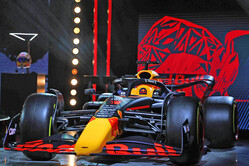


10/02/2022
NEWS STORY
 As his latest creation is unveiled (sort of), Red Bull's design guru, Adrian Newey, explains the theory behind the rules overhaul.
As his latest creation is unveiled (sort of), Red Bull's design guru, Adrian Newey, explains the theory behind the rules overhaul.
In many ways, the 2022 launch season is beginning to look to be a bit of a damp squib.
Thus far, two cars have been 'revealed', but there is increasing debate as to whether either of them bear any relation to the real thing.
Ignoring the fact that the VF-22 unveiled last week was effectively renders of the F1 'show car', it is now widely agreed that the RB18 proudly displayed by Mas Verstappen and his team yesterday was essentially a mock-up.
Opinion remains divided as to whether this is because the real car isn't entirely ready or whether the Austrian team, like its rivals, its determined to hold back its 2022 contender until the last possible minute, thereby not giving away valuable insight into how it has interpreted the rule changes.
While the car revealed at launches rarely has much in common with the car that begins testing, far less that which appears at the first race, the rules overhaul is causing team to keep their powder dry until the last possible moment this season.
Opting not to give a detailed explanation of the RB18, Adrian Newey instead chose to explain the philosophy behind the rules overhaul.
"It's been a very unusual process, this one," he admits. "It's a huge regulation change, the biggest one we've had since 1983 when the venturi cars were banned and flat bottoms cars introduced.
"So the aerodynamic changes, which lead as a representation to this, are designed to help overtaking," he adds. "The theory is that if you create a shape where, as the downforce is produced, that always produces up-wash at the back of the car, so you get this kind of rooster tail coming up at the back.
"If that then back-fills and side-fills from underneath then the wake from the car goes above the car that's following, so therefore the car behind keeps its downforce much better."
"What they wanted to do is clearly generate downforce from the ground," adds technical director, Pierre Wache, "compared to before was generated by the ground but also mainly by the front wing, rear wing, and bodywork.
"You will affect, for sure, the ride of the cars and mechanical grip, and for sure the drag of the car because this generation of downforce is quite efficient, then this type of car should be a lot quicker on the straights.
"The nose box is certainly longer," he adds, "so wherever you put your split for frontal chassis into the structure at the front, that structure has got a lot longer – the overhang is greater," explained Paul Monaghan, Red Bull's chief engineer.
"The thinking is road relevance," he says of the larger wheels. "The majority of road cars now have relatively big wheels, but they also come with pretty low profile tyres.
"We've come up on the wheel size to 18 inches, as a line in the sand. It's suddenly put a bit of weight onto the car. "The tyre is bigger overall, so it has a fairly significant aerodynamic effect, and then you've got the characteristics of the big tyre to try and understand as well."